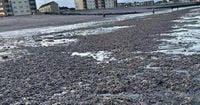Residents of Kirkcaldy, a coastal town in Fife, Scotland, woke up on September 9, 2025, to an astonishing and unsettling sight: hundreds of thousands of starfish strewn across the sands and rocky stretches of Kirkcaldy Beach and its promenade. The scale of the event, described by some on social media as a “starfish apocalypse,” left locals and visitors alike both amazed and concerned, as thick carpets of the invertebrates covered large swathes of the shoreline and even spilled onto nearby walkways.
According to BBC News, the phenomenon began on the night of September 8, as a particularly high tide—coinciding with the full moon—brought strong onshore winds and heavy seas to the Fife coast. The next morning, beachgoers found the aftermath: countless starfish, most of them dead, with only a handful surviving in shallow pools left behind by the receding tide. “I’ve never seen anything like it,” said Helen Clark, a Kirkcaldy resident of 50 years. “But I did see the strong winds yesterday, because all this sand was blowing up, so that could be a reason for it.” Her son Andrew, who had traveled from nearby Inverkeithing, echoed her astonishment: “I can’t understand why they’re all dead, first and foremost. Something’s killed them. What it is I don’t know. They need to get somebody down to have a look at it, I would say. But to see so many, it’s amazing.”
Local authorities and environmental agencies quickly moved to assess the situation. The Fife Coast and Countryside Trust, responsible for monitoring the area, conducted an inspection on the morning of September 9. Their spokesperson told Fife Free Press that storm events and onshore winds can, from time to time, disturb the seabed significantly enough to dislodge starfish and other invertebrates. “Invertebrates (like starfish), crabs and other crustaceans are vulnerable to wash ups as they tend to live in or migrate to shallow water making them more likely to be swept on to our beaches as the tide ebbs and flows. It’s common in the autumn and winter months but can happen all year round.” The Trust decided that, for now, it was best to let the natural coastal process reclaim the dead starfish, while continuing to monitor the situation. They also alerted dog owners, as starfish can be poisonous to dogs if ingested.
Experts have pointed to a combination of natural factors behind the mass stranding. Dr. Lyndsey Dodds of WWF Scotland told STV News that while it’s disturbing to see so many starfish washed up in one place, it’s likely a natural event. “It’s not totally clear why this has happened, the most likely cause is a natural one such as increasing storms and high tides,” she explained. “What the starfish actually do in storm conditions is they roll up into a ball and they move with the waves and currents. So that can result in hundreds and thousands of them all coming together in one place.” This behavior, known as “starballing,” was first observed by experts at Plymouth University’s Marine Institute, who noted that starfish curl their arms into a ball shape to float with the current when tides and winds pick up. Dr. Emma Sheehan, who led those observations, remarked, “During the survey, the tides and wind picked up and to our complete surprise, starfish started flying past the camera, with their arms curled into a ball shape. It was previously thought that the only mode of movement for adult starfish was to slowly crawl along the seabed. However, we now think that they can also use strong tides to relocate efficiently to other feeding grounds, or re-group with other starfish for breeding.”
Professor David Ferrier of the Scottish Oceans Institute at the University of St Andrews reinforced the natural explanation, telling STV News, “If these heavy seas and strong currents caught an area of the seabed with lots of these starfish, then they will simply have been caught up in the waves and washed ashore. This is most likely an unfortunate – for the starfish – natural event. Nothing to be worried about.” He added that starfish can survive out of water for only a matter of minutes if they are completely high-and-dry. “If they are still alive when found, then it is worth putting them back in the sea and they may well recover and be fine. It is easy to see if a starfish is alive or not, as the hundreds of tube feet with suckers on the animal’s underside will be slowly moving around trying to gain a purchase on something.”
Despite the scientific reassurances, the event left many residents and visitors deeply moved. Some people, including families with young children, attempted to rescue live starfish by gently returning them to the sea. One mother wrote on Facebook, “Some are still alive. Me and my five year old rescued some by putting them in sea water near the rocks (we were gentle).” However, the Scottish SPCA advised caution, urging the public not to touch the starfish and to keep dogs on leads to avoid poisoning risks. “If anyone is concerned that their dog may have ingested one, we’d recommend seeking advice from their local vet,” the organization stated.
This is not the first time such a phenomenon has occurred on Scotland’s east coast. According to BBC News and STV News, similar mass strandings happened in Kirkcaldy in 2023, and elsewhere in the region during Storm Arwen in 2021 and Storm Emma in 2018. In 2017, thousands of starfish were stranded on the Moray Firth over several weeks due to starballing. These events tend to coincide with strong storms, high tides, and particular lunar phases, such as the full moon, which can produce extra-high and extra-low tides due to the alignment of the sun, moon, and Earth.
The Scottish Environment Protection Agency (SEPA) confirmed its awareness of the Kirkcaldy event, stating, “These events are part of the natural cycle of marine life, and similar incidents have been reported along the east coast of Scotland in previous years.” SEPA also noted that such strandings can occur during spawning, when starfish are more likely to be dislodged from the seabed.
However, there is a growing concern among scientists that these events may become more frequent as climate change intensifies storm activity in Scottish waters. Dr. Dodds warned, “Unfortunately with climate change we are seeing increasing storm events so it could be that we see more storms which could lead to more and more strandings like this. Which could potentially impact marine life.”
For now, the mass stranding at Kirkcaldy Beach serves as a dramatic reminder of the power of nature—and the vulnerability of even the most resilient sea creatures to its forces. As the tides reclaim the starfish and life on the beach returns to normal, the event lingers in the minds of those who witnessed it, prompting questions about the changing climate and the delicate balance of marine ecosystems.





